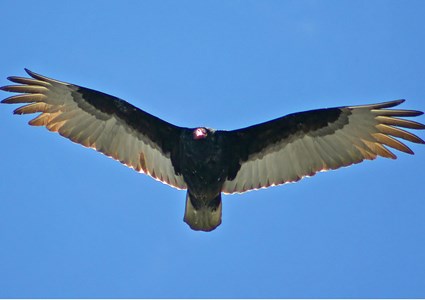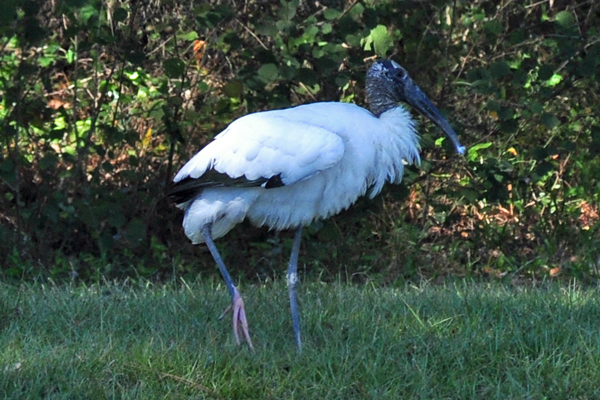The other day, as I was driving away from a friend's house out in the country, I saw two gigantic black shapes up in a tree. They were so big, I thought they couldn't be birds, they must be black trash bags caught in the tree or maybe someone had put statues of owls up in the tree to scare away the woodpeckers. But when I looked again, I realized they were actually birds. They were so enormous, I knew they had to be turkey vultures.
I stopped, turned around, pulled over to the side of the road, and took pictures using my handy built-in zoom lens. They didn't move, and they looked so bizarre that, even though I was looking at them through my camera, I doubted for a moment that they were real. They looked like statues, or somebody's bizarre idea of what clown-birds from outer space might look like. Then they moved. It kind of spooked me.

A pair of turkey vultures (a.k.a. clown-birds from outer space)
(Photo by the Apple Lady)

The light vs. dark coloring on the underside of the turkey vulture might be the most obvious identifier.
(Photo from the Cornell Lab of Ornithology)
I stopped, turned around, pulled over to the side of the road, and took pictures using my handy built-in zoom lens. They didn't move, and they looked so bizarre that, even though I was looking at them through my camera, I doubted for a moment that they were real. They looked like statues, or somebody's bizarre idea of what clown-birds from outer space might look like. Then they moved. It kind of spooked me.

A pair of turkey vultures (a.k.a. clown-birds from outer space)
(Photo by the Apple Lady)
Basic Facts & Identification
- Turkey vultures can be anywhere from 25 to 32 inches long, or roughly 2-1/2 feet long. That's just slightly smaller than a bald eagle.
- They have a wingspan of 6 feet. That's right, their wingspan is as wide as a man is tall.
- For all their size, they only weigh about 6 pounds. I guess that's part of being a bird and having those special bones that are hollow enough to allow for flight.
- You most often see turkey vultures flying up in the sky. They look big enough to be a hawk or an eagle, but you can tell they're turkey vultures by a number of traits:
- They tend to wobble or teeter as they soar. They're either trying to catch thermals and get a better lift, or trying to catch scents.
- The undersides of their bodies are black but their tail feathers are white, so if you see a distinct dark vs. light coloring on the underside, it's probably a turkey vulture.
- Sometimes even though they're up in the sky, you can make out the red head.

The light vs. dark coloring on the underside of the turkey vulture might be the most obvious identifier.
(Photo from the Cornell Lab of Ornithology)
Don't They Eat Dead Things? And Isn't that Gross?
- Turkey vultures eat carrion -- the flesh of dead animals and birds. A lot of people think they're scavengers that pick off the food that other animals have killed, but most of the time, they are the first to arrive on the scene where an animal has died, whether the animal was hit by a car, or succumbed to disease, or was injured and managed to get away but died later.
- Turkey vultures are so quick to arrive because they have an extraordinarily powerful sense of smell. When they're up soaring above the canopy of the trees, they can detect the minutest scent of carrion coming up from the ground through the trees into the sky.
- Because they eat the flesh of dead animals, most people think vultures are ugly, or undesirable, or a bad omen. But they are, as Hagrid would say, "dead useful." Not only do they take care of dead animals -- something most of us wouldn't want to do -- but they have really remarkable immune systems. Most of us avoid dead animals because the corpses are rife with bacteria and all sorts of other nasty things that would make us very sick. Not turkey vultures. They can eat all sorts of stuff and they are not affected by things like botulism, cholera, salmonella, or even anthrax.
- In fact, even their droppings are disease-free. So they really help clean up the place.

Sometimes you see turkey vultures hanging around with their wings open a little, like this. They're probably letting their feathers dry after a heavy dewfall, or else regulating their body heat.
(Photo from Ask the Birds and They Will Tell You)
- Tibetan Buddhists regard the vulture in a positive light, as a creature that helps release the human soul from the dead body. The Latin word for the turkey vulture reflects this view: Cathartes aura means "golden purifier" or "purifying breeze."
- One of the few things that harm turkey vultures is lead shot. If a turkey vulture eats an animal that has been shot by a hunter, the vulture will also consume the ammunition, and then eventually it will contract lead poisoning.
- You don't want to be without vultures (turkey or otherwise). In some parts of urban India where accidental poisoning killed off so many of the vultures, there aren't enough of the birds to clean up the dead animals. So now details of people have to go around burying animals so that people don't get sick.
- So, yes, they eat dead things. But they're really good at it, and they're doing everyone else a huge favor.
- One little note: just because they're circling doesn't necessarily mean they're closing in on something dead down below. They could just be traveling as a group on the same thermal.
- A group of vultures circling is called a kettle. If they're just hanging out, not flying, then they're called a venue.

These turkey vultures may look like they're circling over some carrion, but actually, they're just migrating.
(Photo from Cornell Lab of Ornithology's Birdscope)
Turkey Vultures & Wild Turkeys
- The fact that they eat carrion is why they don't have feathers on their heads -- or at least, that's what we assume. Vultures can eat and not be affected by all sorts of toxins, but it might be a different thing if they went around with that toxic stuff in their face-feathers.
- By the way, turkey vultures keep their leg feathers clean by urinating on themselves. That may sound gross and terrible, but actually the uric acids kill any bacteria they may have picked up, and it's what helps keep themselves healthy.
- The turkey vulture's bald head is why they're named after turkeys. Because they look kind of like a wild turkey.

The wild turkey has a bald head like a turkey vulture does, but it also has the wattle under its chin and that knob over the beak which is called a snood.
(Photo by the Apple Lady)
- But there are several differences between the two types of birds. Besides the fact that wild turkeys can't fly much higher than low tree branches, as compared to turkey vultures which like to get up there and soar around on the thermals, and the fact that turkey vultures' feathers are more brown while wild turkeys' feathers are more blue-black, there's also a difference in that bald head.
- The head of a turkey vulture is red and bald. A wild turkey's head isn't entirely featherless, and the male's head may be blue, red, or white, depending on the time of year. It is thought that the color changes are associated with trying to attract a mate, or trying to intimidate other male rivals. The female wild turkey's head is gray-blue and does not change.
Vultures, Buzzards, and . . . What?
- A lot of Americans use the word "buzzard" to describe vultures, especially out West. Actually, buzzards are types of hawks that live in Europe (they're related to the red-tailed hawk that we have in the States and look somewhat similar). The misuse probably came about when people from Europe saw vultures and thought they were the same thing as buzzards. But they're not.
- Now here's a tidbit that will really tweak your vulture ideas: for a long time, scientists classified vultures with the big birds of prey like hawks and eagles. But actually, DNA tests show that vultures are not related to raptors (who, for example, have almost zero sense of smell) but rather are more closely related to storks. Yup, the ones that bring the babies. Let that float around in your boat for a while.

Wood stork, more closely related to the turkey vulture than the turkey or the hawk.
(Photo from Birds and Gators)
Sources
Cornell Lab of Ornithology, Turkey Vulture (Cathartes aura)
Wisconsin Department of Natural Resources, Environmental Education for Kids, Turkey Vulture
Turkey Vulture Society, Turkey Vulture Facts, Maps, and Statistics
Adirondack Wildlife, Turkey Vultures
Adirondack Wildlife, Turkey Vultures
National Wild Turkey Federation, What Does a Wild Turkey Look Like?
No comments:
Post a Comment
If you're a spammer, there's no point posting a comment. It will automatically get filtered out or deleted. Comments from real people, however, are always very welcome!